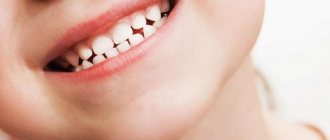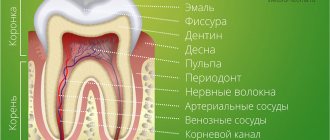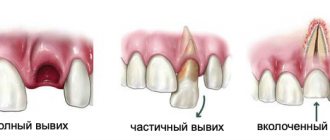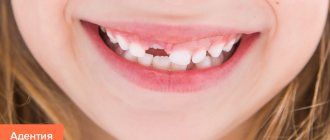What do the deadlines depend on?
When determining why a child’s teeth do not grow, you need to take into account the following factors:
- the formation process depends on gender, girls develop teeth earlier than boys;
- The baby's growth also affects teething. So, if the baby is not tall, then teething will begin later;
- upper and lower jaws. At what stage does teething occur earlier? On the bottom.
A child’s bite has two stages – temporary and permanent. If it is temporary, then teething occurs less frequently. The location of the teeth also matters, for example, the second and third molars emerge later than the others. It is influenced by development and climate, place of residence, heredity - when the parents began to teethe, their children will begin to do so at about the same age.
If the tooth has not grown, we will pull it out
IF THE TOOTH HAS NOT GROWN, WE WILL PULL IT OUT
An orthodontist is a doctor who is especially popular today not only among children, but also among adults. It is relatively easy for children to straighten their teeth while the jaw bones are still young and pliable. But in adults, bite treatment is no longer a problem. Most often, orthodontic treatment is required when a person decides to undergo prosthetics. He comes, as expected, to the orthopedist, and he is immediately referred to the orthodontist. There are several reasons for this,” says medical orthodontist Roman Labzin.
One of the reasons is that there is not enough space in the mouth for dentures, which means that the dentition needs to be moved apart. Crowded teeth also require correction of their position. In general, an orthodontist is the first doctor who prepares the mouth for prosthetics.
Or could it happen that after visiting the orthodontist, you won’t need prosthetics? Will all teeth fall into place or will they successfully take someone else’s teeth?
Through orthodontic treatment, it is actually possible to replace missing teeth and do without prosthetics. For example, a patient once had his lower sixth teeth removed. He is faced with a choice - either to install an implant at great expense and cover it with a crown, or... to move nearby teeth. Typically, such people have problems with their bite and teeth alignment. By correcting the bite, I can close the gap of the extracted tooth - that is, kill two birds with one stone.
Some kind of “epidemic” has begun with malocclusions - you walk around the city and see almost every second person has braces on their teeth, and, surprisingly, in adults.
And this is not surprising. It is adults who most often turn to the orthodontist due to malocclusion. This problem actually occurs in every second person. The bad habits that adults instill in children, starting from infancy, play a detrimental role in this. For example, the habit of using a pacifier. I had a girl who did not take the pacifier out of her mouth until she was six years old. And as they get older, children begin to eat incorrectly—swallowing food, chewing it poorly. Apparently, looking at adults who are always in a hurry somewhere. Due to products that are already sold in a “chewed” state - yoghurts, muesli, baby purees, children and teenagers no longer need to chew, therefore teeth do not grow, jaws do not change and an anomaly is formed. Add here pathologies from the nasal cavity - adenoids, which in our humid climate develop in almost all children, and you get another reason for improper development of the jaw.
How exactly do adenoids affect teeth?
Due to adenoids, nasal breathing is impaired, and the child constantly breathes through the mouth. His lower jaw droops, and his upper jaw becomes very narrow, so there is not enough space for all his teeth, and they grow, overlapping each other. There are many reasons for the development of malocclusion. The most important function of teeth is chewing, so chewing is essential for both children and adults.
And if an adult has nothing to chew, is it not harmful for him to go without teeth for years?
Of course, it is harmful, now for the gastrointestinal tract, since undigested food causes gastritis and ulcers. In addition, ten years after losing teeth, such deformations will occur in the oral cavity that it will be very difficult to restore a normal bite. Rational prosthetics must be done on time.
How long after root removal do I have to wait before getting prosthetics?
It is better to do this within six months, or at most, up to a year.
How does your bite change with age?
First of all, the depth of the bite changes. While eating, the teeth rub against each other and gradually wear down and decrease in height. Such physiological wear of teeth over the years can significantly shorten them and lead to periodontitis. When this process occurs too quickly, pathological tooth wear develops, which causes a deep bite. A deep bite is a jaw condition in which the upper teeth overlap the lower teeth by more than one-third of the incisor crowns.
So, you should nibble on carrots while you’re young, and switch to more gentle food as you get older?
Of course, after 50 years it is better to take care of your teeth. Moreover, if the teeth wear evenly, the orthodontist will not help. Then it is better to contact an orthopedist, who can prevent further tooth wear by placing crowns on them.
What other bite pathologies are there?
Medial bite – when the lower jaw protrudes and the lower teeth protrude above the upper teeth. This pathology does not give a very aesthetic appearance to the face, but it is most often congenital and genetically inherited. Orthodontic treatment will not help here; maxillofacial surgery is necessary.
Changing the bite does not have a very good effect on appearance...
Yes, a decrease in bite height due to tooth wear leads to a visual reduction in the lower third of the face and a deepening of the nasolabial fold. Of course, this ages the face. Therefore, dental prosthetics and, accordingly, orthodontic treatment should be carried out in due time.
Until what age can a bite be cured?
One client I gave braces to was 58 years old. She had an impacted canine - a tooth that had formed at one time, but never erupted. Many years ago, the dentist apparently did not notice it, and when her baby tooth fell out, he gave her a denture, which she wore all her life. And we carried out orthodontic treatment and pulled this canine out. Now she has her own real tooth.
How often do such situations occur?
I have several patients with impacted fangs, some have one tooth left in the bone, others have both. Quite often the upper incisors fail to grow in, this happens for various reasons. One of the most common is the removal of baby teeth in early childhood. It very rarely happens the other way around. Milk teeth are retained until a person is 25 years of age or older. And the permanent tooth not only does not grow, but is completely absent from the bone. Then you have to place an implant and also carry out orthodontic treatment. Braces are the most popular type of correction among people. And when they do not help, then you have to resort to other structures, including removable ones. There are many treatment methods, of which I choose only those that are suitable for a particular person with his bite and problems.
What are the main indications for treatment by an orthodontist?
The main indication is teeth that are incorrectly positioned or grown in the wrong place. Of course, a greatly altered bite, which we have already talked about. Small changes in the bite are difficult for a person to determine on their own, so it would not hurt for every person to come for a consultation with an orthopedist at least once.
You can go to the orthodontics section at the multidisciplinary clinic “Panorama Med” here .
To make an appointment with an orthodontist, call: +7 (812) 244-90-10 and 8 (812) 970-00-70
Is late tooth growth dangerous?
If baby teeth do not grow, then in general this does not pose a danger, but it cannot be done without the intervention of a doctor. The specialist must conduct a preventive examination, talk with the parents, determining their teething characteristics, and then determine whether there is a reason for concern or not. Studies have shown that if the cause is heredity, then problems with permanent teeth are possible in the future.
What causes late eruption:
- health problems with the mother during pregnancy (for example, severe toxicosis);
- various diseases.
Incorrect placement of primary teeth affects the location of permanent teeth.
What types of delayed eruption are there?
Currently, doctors talk about two main types of delayed eruption.
The first is retention. Pathology is diagnosed in 1-7% of cases, and retention can be associated with both baby teeth and permanent teeth. The essence of the disorder is that the teeth have already formed, but have not yet erupted. The pathology can be caused by various anomalies: improper formation of buds, inflammatory processes, hematomas. In many children, the canines of the upper jaw are susceptible to retention.
The causes of adentia are not fully understood
The second type is edentulous. This is a more dangerous pathology in which the absence of teeth (complete or partial) is detected. The absence of all teeth is extremely rare, and the reasons for such an anomaly are not fully understood. Usually we are talking about problems with the formation of tooth germs in the prenatal period, and this, in turn, is provoked by various external factors (infections and inflammations, poor lifestyle of the mother, complicated pregnancy, deficiency of nutrients). In case of edentia, an x-ray is prescribed, during which it is determined whether there are any rudiments of milk teeth in the jaw. If they are present, the reason why teeth are not erupting is determined.
What causes delayed teething in children?
It must be said that there are many reasons for the delay in the appearance of baby teeth, and most often harmless factors are found. At the same time, the dentist recommends simple stimulation of teething (massage of the gums, use of special gels), and soon the long-awaited teeth take their places.
The reasons for late teething in children include:
- Hereditary factor
- Insufficient amount of useful elements (vitamin D, calcium). In this sense, infants are at risk because artificial formulas contain more minerals that promote the growth and development of teeth
- Congenital pathologies (the presence of supernumerary teeth that interfere with the eruption of the rest, tumors of various natures, regional odontodysplasia, a genetic disorder in the development of the jaws, cleft palate, cleft lip, etc.)
- Bruises, injuries, consequences of previous diseases
- Pathologies of the endocrine system (impaired hormone secretion)
- Prematurity (babies born prematurely develop more slowly than their peers)
- Past diseases and disorders during intrauterine development (lack of nutrients, poor maternal lifestyle), complicated pregnancy
- Congenital rickets
- Anemia
- Ichthyosis
- HIV infection
- Long-term chemotherapy or anticonvulsants
- Genetic abnormalities: Gardner syndrome, Down syndrome
- Delayed physical and mental development
If some of the above causes are diagnosed (for example, rickets), a cure, unfortunately, is impossible.
However, the vast majority of clinical cases are nothing more than parents’ vain worries. Most often it turns out that delayed teething is not a pathology, but a developmental feature.









